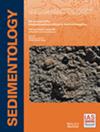Deep learning-based grain-size decomposition model: A feasible solution for dealing with methodological uncertainty
IF 2.8
2区 地球科学
Q1 GEOLOGY
引用次数: 0
Abstract
Terrigenous clastic sediments cover a large area of the Earth's surface and provide valuable insights into the Earth's evolution and environmental change. Sediment grain-size decomposition has been widely used as an effective approach to inferring changes in sediment sources, transport processes and depositional environments. Several algorithms, such as single sample unmixing, end-member modelling analysis and the universal decomposition model, have been developed for grain-size decomposition. The performance of these algorithms is highly dependent on parameter selections, introducing subjective uncertainty. This uncertainty could undermine the reliability of decomposition results, limit the application of grain-size decomposition techniques and reduce comparability across different studies. To mitigate the methodological uncertainty, a novel deep learning-based framework for grain-size decomposition of terrigenous clastic sediments is proposed. First, an improved universal decomposition model is used to analyse the collected grain-size data, in order to provide training sets for the end-to-end decomposers. To meet the data size requirements of supervised learning, generative adversarial networks are also trained for data augmentation. The performance of the new framework is then evaluated using a small-scale dataset (73 393 samples from 18 sites) of three sedimentary types (loess, fluvial and lake delta deposits). The decomposed grain-size results demonstrate high feasibility and great potential of the framework in constructing a robust grain-size decomposition model. Finally, it is proposed that future grain-size research should aim to establish guidelines for grain-size data sharing and produce a big grain-size database for deep learning.基于深度学习的粒度分解模型:处理方法不确定性的可行解决方案
原生碎屑沉积物覆盖了地球表面的大片区域,为了解地球的演化和环境变化提供了宝贵的信息。沉积物粒度分解被广泛用作推断沉积物来源、迁移过程和沉积环境变化的有效方法。目前已开发出几种粒度分解算法,如单一样本非混合法、末端成员建模分析法和通用分解模型。这些算法的性能在很大程度上取决于参数的选择,从而带来主观上的不确定性。这种不确定性会削弱分解结果的可靠性,限制粒度分解技术的应用,降低不同研究之间的可比性。为了减少方法上的不确定性,本文提出了一种基于深度学习的全新框架,用于陆相碎屑沉积物的粒度分解。首先,使用改进的通用分解模型来分析收集到的粒度数据,以便为端到端分解器提供训练集。为了满足监督学习对数据量的要求,还对生成对抗网络进行了训练,以增加数据量。新框架的性能随后通过三个沉积类型(黄土、河流和湖泊三角洲沉积)的小规模数据集(来自 18 个地点的 73 393 个样本)进行了评估。粒度分解结果表明,该框架在构建稳健的粒度分解模型方面具有很高的可行性和巨大的潜力。最后,建议未来的粒度研究应致力于建立粒度数据共享准则,并为深度学习建立大型粒度数据库。
本文章由计算机程序翻译,如有差异,请以英文原文为准。
求助全文
约1分钟内获得全文
求助全文
来源期刊

Sedimentology
地学-地质学
CiteScore
8.20
自引率
11.40%
发文量
94
审稿时长
6-12 weeks
期刊介绍:
The international leader in its field, Sedimentology publishes ground-breaking research from across the spectrum of sedimentology, sedimentary geology and sedimentary geochemistry.
Areas covered include: experimental and theoretical grain transport; sediment fluxes; modern and ancient sedimentary environments; sequence stratigraphy sediment-organism interaction; palaeosoils; diagenesis; stable isotope geochemistry; environmental sedimentology
 求助内容:
求助内容: 应助结果提醒方式:
应助结果提醒方式:


